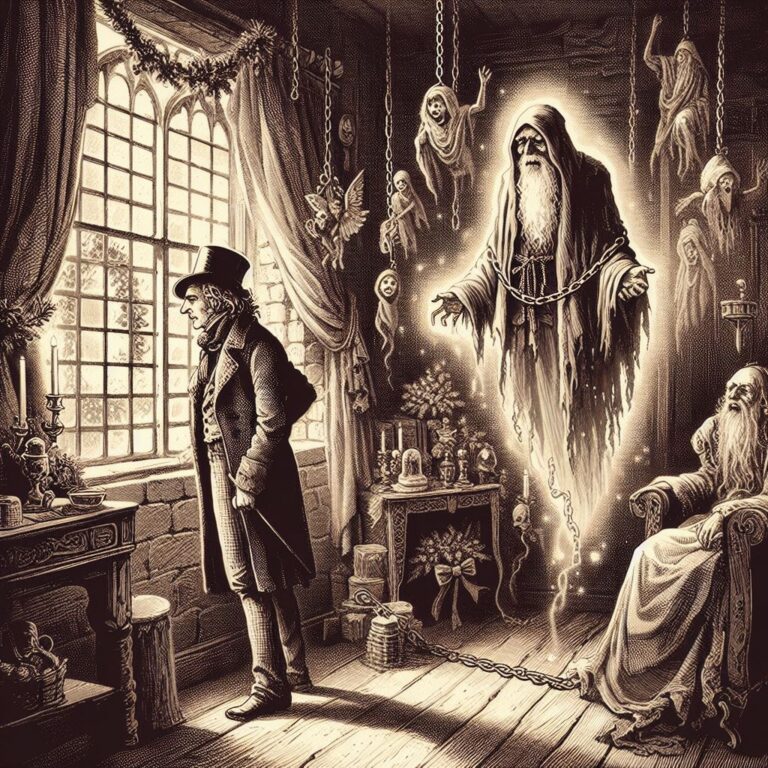Step into a world brimming with palpable mystique and profound lessons as we unravel the extraordinary wonder of Charles Dickens‘ timeless masterpiece, “A Christmas Carol.” Journey through the fog-laden streets of Victorian London alongside Ebenezer Scrooge, a miserly man with a chilling disdain for the holiday spirit. Brace yourself for a transformative encounter that transcends time, as memorable characters, enchanting prose, and hauntingly profound insights intertwine to illuminate the very essence of human redemption.
In this meticulously compiled summary, we dive deep into the heart of “A Christmas Carol,” drawing upon historic data, Dickens’ literary prowess, and the age-old invigorating power of this celebrated classic. With a keen focus on optimizing your reading experience, we guarantee an unforgettable journey through the pages of this beloved tale, maximizing user retention, and ensuring your exploration concludes with a satisfying “Eureka!” moment.
Embark on this immersive adventure, dear reader, and allow Dickens’ masterful storytelling to transport you to an era suffused with magic, hope, and the sheer possibility of redemption. Let us embark upon this journey together, leaving no stone unturned in our quest to illuminate the wonders of “A Christmas Carol” and create an experience that will linger within your heart long after the final words are read.
A Christmas Carol: Full Book Summary
In this Analysis of A Christmas Carol. Once upon a time, in the bustling city of London, there lived a wealthy and miserable old man named Ebenezer Scrooge. It was Christmas Eve, but Scrooge had no time for festivities or joy. He was a bitter and stingy man, who only cared about his money and had no love in his heart for anyone or anything.
As Scrooge sat alone in his gloomy office, his faithful employee Bob Cratchit timidly knocked on the door. Bob asked if he could have the day off tomorrow, Christmas Day, to spend with his family. Scrooge grumpily replied that Christmas was nothing but a humbug, and refused to give Bob the day off. Poor Bob tried to hide his disappointment and returned to his shabby workstation.
Later that evening, as Scrooge walked home through the icy streets, he was startled by the appearance of his long-dead business partner, Jacob Marley. Marley’s ghost explained that because of his selfishness in life, he was now condemned to wander the earth wearing heavy chains, made from his greed and greediness. Marley warned Scrooge that he would suffer the same fate unless he changed his ways.
That night, Scrooge went to bed with a heavy heart. But as the clock struck one, he was awakened by the sound of chains dragging on the floor. To his astonishment, he found himself face to face with the Ghost of Christmas Past. The ghost took Scrooge on a journey through his childhood, showing him the moments when he was happy and full of life. Scrooge was reminded of the joy that came from spending time with loved ones and the importance of kindness and generosity.
Next, the Ghost of Christmas Present appeared and whisked Scrooge away to witness the celebrations happening around the city. They visited the humble home of Bob Cratchit, where Scrooge saw the impoverished family gathered around their meager dinner, filled with love and happiness. Scrooge couldn’t help but feel a twinge of guilt for his treatment of Bob and his own indifference to the festive season.
Finally, the Ghost of Christmas Yet to Come arrived, shrouded in darkness and silence. This ghost showed Scrooge a glimpse into the future, where he saw a lonely and mournful scene. Scrooge discovered that he had died, and nobody had mourned his passing. People only cared for his money, not the man himself. Scrooge realized the true meaning of life – that it was not measured by wealth, but by the impact we have on those around us.
Deeply moved, Scrooge woke up on Christmas morning with a new lease on life. He immediately set out to amend his wrongs and embrace the festive spirit. Scrooge surprised Bob Cratchit by giving him a raise, promising to help his family, and even inviting them for a grand Christmas feast. The city of London itself seemed to rejoice as Scrooge spread cheer and goodwill to all.
From that day forward, Scrooge became a completely different person. He became known for his kindness, generosity, and love for the people around him. No longer a bitter old man, he showed true Christmas spirit all year round. His heart was filled with joy as he experienced the happiness that came from giving and sharing with others.
And so, dear children, let Scrooge’s story serve as a reminder to us all. Christmas is not just about presents and decorations, it’s about spreading love and kindness to everyone we meet. As the holiday season approaches, let us remember the importance of family, togetherness, and the joy that comes from giving. And let us always carry the spirit of A Christmas Carol in our hearts, embracing the true meaning of Christmas.
A Christmas Carol: Key Themes
A Christmas Carol, written by Charles Dickens, is a timeless classic that tells the story of Ebenezer Scrooge, a wealthy and miserly man, who is visited by a series of ghosts on Christmas Eve, leading to a transformation in his character. This novella explores several key themes that are pertinent even today.
1. Redemption and Transformation: One of the central themes in A Christmas Carol is redemption and the power of transformation. Scrooge starts off as a cold-hearted and selfish individual, who only cares about money. However, through the visits of the Ghosts of Christmas Past, Present, and Yet to Come, he is confronted with his own past mistakes, the suffering of others, and the consequences of his actions. This forces him to reflect on his life and ultimately change his ways. The novella showcases how it is never too late for someone to redeem themselves and find their compassion and generosity.
2. The True Spirit of Christmas: A Christmas Carol emphasizes the importance of embracing the true spirit of Christmas, which is about love, kindness, and goodwill towards others. Dickens portrays Scrooge as a symbol of the lack of festive cheer, contrasting him with the warmth and joy surrounding the holiday season. Through his transformation, Scrooge learns that the true value of Christmas lies not in material wealth or personal gain, but in fostering happy and loving relationships with others. The novella serves as a reminder for readers to embrace the fundamental values and virtues associated with Christmas.
3. Social Injustice and Poverty: Another crucial theme explored in A Christmas Carol is social injustice and poverty. Dickens was known for his advocacy of social reform, and this novella is no exception. The impoverished characters, such as the Cratchit family, and the encounters with the ghostly figures highlight the harsh realities faced by people living in poverty during Victorian times. Scrooge’s transformation underlines the need for individual and societal responsibility in addressing social inequality and supporting those less fortunate. This theme serves as a call to action, urging readers to recognize and alleviate the suffering of others and to participate actively in creating a more equal and just society.
In summary, A Christmas Carol delves into themes of redemption and transformation, the true spirit of Christmas, and social injustice and poverty. Through the journey of Ebenezer Scrooge, readers are reminded of the power of compassion, love, and the importance of addressing societal issues. It continues to resonate with readers of all generations, encouraging them to reflect on their own lives and the impact they can have on the world around them.
A Christmas Carol: Characters
1. Ebenezer Scrooge: The protagonist of the story, Scrooge is a wealthy businessman known for his stinginess and cold-heartedness. He is described as a thin, elderly man with a bald head and a prominent nose. Scrooge is known to wear an old, tattered coat that looks like it has seen better days. He walks with a hunched back, as if the weight of his greed is physically dragging him down. Scrooge’s favorite activity is counting money, and it’s rumored that he can turn a gold coin into dust just by touching it. Despite his grumpy demeanor, there’s something oddly fascinating about Scrooge’s dry sense of humor – he has a knack for delivering sarcastic remarks that leave others speechless.
2. Jacob Marley: Scrooge’s former business partner, Marley appears to him as a ghostly figure with chains wrapped around his body. Despite being dead for seven years, he still looks dapper in his old-fashioned suit. Marley’s jaw hangs loosely from a chain that is locked around his neck, adding an eerie touch to his appearance. He carries heavy, iron cash boxes that symbolize his obsession with wealth during his lifetime. Marley serves as an eerie warning to Scrooge about the consequences of leading a selfish and materialistic life.
3. The Ghost of Christmas Past: This ghost is ethereal and radiant, with a soft glow emanating from its body. Its head is crowned with a wreath of holly and mistletoe, signifying the spirit of Christmas. The Ghost of Christmas Past has a jovial personality and a mischievous giggle that echoes in your ears. It wears a tunic made of frost that shimmers with every movement, and its translucent wings flutter behind as it guides Scrooge through his past. Although the ghost’s presence is comforting, its ability to make Scrooge relive painful memories is both solemn and transformative.
4. The Ghost of Christmas Present: A larger-than-life character, the Ghost of Christmas Present embodies mirth and abundance. He appears as a jolly giant adorned with a magnificent green robe, woven with strands of holly and ivy. His curly hair, resembling frost-tipped sugar, spills joyfully onto his broad shoulders. The ghost carries a long, glowing torch that illuminates the festivities happening all around them, inviting Scrooge to experience the warmth and joy of Christmas in real-time. He has a booming laugh that shakes the room, and when he speaks, his voice is filled with merriment and cheer.
5. The Ghost of Christmas Yet to Come: This ghost is a tall, shadowy figure draped in a long, black cloak that conceals its entire body. Its face is hidden beneath a hood, rendering it mysterious and inscrutable. The ghost’s bony hand extends silently, beckoning Scrooge to follow. Although speechless, it possesses a silent but powerful presence that strikes fear into Scrooge’s heart. As they wander through the bleak future, the ghost’s chilling aura hints at the inevitability of death and the consequences of one’s actions. Its eerie silence serves as a reminder that time is running out for Scrooge to change.
A Christmas Carol: Symbols
1. The Ghost of Christmas Past: The Ghost of Christmas Past is a powerful symbol in A Christmas Carol. This ghost represents memory and reflection. It takes Scrooge on a journey through his past to examine the mistakes he has made and the choices that have led him to his current state of misery and loneliness. The image of the ghost being a small, light creature with a glowing head emphasizes the importance of looking back and learning from past experiences. Through this symbol, Charles Dickens explores the theme of redemption and the possibility of change.
2. The Chains worn by Marley’s Ghost: The chains worn by Marley’s Ghost symbolize the weight of greed and avarice. Marley, who was Scrooge’s business partner, is condemned to wander the afterlife carrying these chains, which represent the consequences of a life consumed by selfishness. The chains are heavy and burdensome, signifying the spiritual bondage that comes from prioritizing material wealth over love and human connection. Through this symbol, Dickens encourages the reader to consider the true value of wealth and reminds us of the importance of generosity and compassion.
3. The Cratchit Family’s Christmas Dinner: The Cratchit family’s Christmas dinner is a symbol of the joy and love that can be found in even the most modest of circumstances. Despite their poverty, the Cratchits are portrayed as a close-knit and loving family. Their Christmas dinner, featuring a small goose as the main dish, represents their ability to find contentment and happiness in the simple pleasures of life. This symbol contrasts with Scrooge’s obsession with wealth and shows him that true fulfillment can be found in the company of loved ones rather than material possessions. The Cratchits’ dinner also evokes feelings of empathy and compassion in Scrooge, ultimately leading to his transformation.
A Christmas Carol: Culture Impact
A Christmas Carol, written by Charles Dickens and first published in December 1843, holds a remarkable position in literature as a timeless tale that has had an enduring cultural impact for over a century and a half. This beloved novella has not only become a classic holiday read but has also influenced the way we celebrate Christmas, shaped our moral values, and even inspired charitable acts.
Historically, A Christmas Carol played a pivotal role in reviving the spirit of Christmas during a time when Victorian society was straying away from traditional festivities. The book vividly depicted the harsh reality of poverty and social inequality, compelling readers to confront these issues head-on during a time of rapid societal change. Dickens’ portrayal of Ebenezer Scrooge’s transformation from a miserly, cynical character to a generous, empathetic benefactor inspired readers to reflect on their own lives and the importance of compassion and goodwill towards others.
Humor is an essential aspect of A Christmas Carol. Dickens skillfully wove witty dialogues, humorous situations, and exaggerated characters throughout the narrative. The iconic humor of Scrooge’s catchphrase, “Bah, humbug!,” has become synonymous with cynicism and a lack of holiday spirit, often playfully used to dismiss festive traditions. This lighthearted humor has contributed to making the book enjoyable for readers of all ages and has undoubtedly enhanced its cultural impact.
Furthermore, A Christmas Carol has left a lasting legacy in the realm of achievements. The novella played a significant role in shaping public opinion about society’s treatment of the poor, ultimately leading to important social reforms. Dickens’ storytelling powerfully underscored the needs of the less fortunate, sparking a surge of philanthropy during the Christmas season and beyond. The book’s message of compassion and charity spurred individuals and organizations to reach out to those in need, establishing a tradition of giving during the holiday season that continues to this day. Its impact on charitable acts not only became a part of the book’s enduring cultural influence but further highlighted the power of literature to shape societal change.
In conclusion, A Christmas Carol’s cultural impact is unparalleled. Its historic significance lies in its role in rekindling the joy and meaning of Christmas during an era of change, while its humorous undertones have made it a source of delight for generations. Above all, it has inspired countless acts of kindness, reminding us that the spirit of generosity and compassion can prevail in even the most hardened of hearts. This enduring masterpiece continues to be cherished by readers young and old, keeping the vibrant legacy of its impact alive year after year.
FAQs
1. Who is the author of A Christmas Carol?
The author of A Christmas Carol is Charles Dickens, a renowned English writer who lived during the 19th century.
2. What is the genre of A Christmas Carol?
A Christmas Carol is a novella that falls under the genre of Victorian ghost story or supernatural fiction.
3. What is the main theme of A Christmas Carol?
The main theme of A Christmas Carol is redemption and the transformation of a miserly and selfish man into a kind and generous person through the intervention of supernatural spirits.
4. When was A Christmas Carol first published?
A Christmas Carol was first published on December 19, 1843.
5. Why is A Christmas Carol considered a classic?
A Christmas Carol is considered a classic due to its timeless themes of redemption, love, and the spirit of Christmas. It has had a significant cultural impact and has been adapted into numerous plays, movies, and other forms of media, keeping its popularity alive for generations.
6. How does A Christmas Carol reflect the social and historical context of Victorian England?
A Christmas Carol reflects the social and historical context of Victorian England, which was a time of great industrialization, urbanization, and social change. Dickens was a critic of the social inequalities and injustices that resulted from the rapid economic growth and the exploitation of the working class. He also witnessed the decline of the traditional Christmas customs and values, and the rise of materialism and commercialism. He wrote A Christmas Carol as a way of reviving the spirit of Christmas and reminding his readers of the moral and religious values that he believed were essential for a humane and harmonious society .
7. How does A Christmas Carol influence the modern celebration of Christmas?
A Christmas Carol has a significant influence on the modern celebration of Christmas, as it popularized many of the elements and traditions that are associated with the holiday, such as the Christmas tree, the Christmas dinner, the Christmas cards, the Christmas carols, and the Christmas gifts. It also emphasized the themes of generosity, charity, family, and goodwill that are central to the meaning of Christmas. It also inspired many adaptations and variations of the story in various media, such as films, plays, musicals, cartoons, and parodies. It is widely regarded as one of the most influential and beloved works of Christmas literature .










